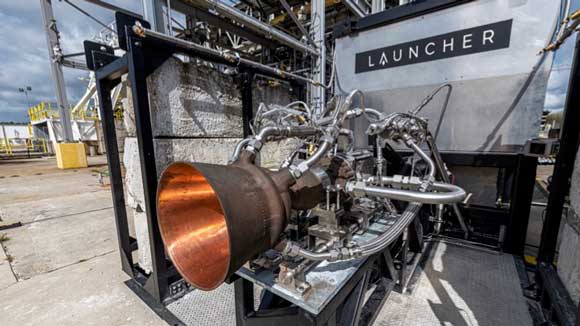Launcher’s additively manufactured E-2 rocket engine successfully tested at NASA Stennis Space Center
April 26, 2022

Launcher, headquartered in Hawthorne, California, USA, reports that its additively manufactured E-2 liquid rocket engine has successfully demonstrated nominal thrust, pressure and oxidiser/fuel mixture ratio for the first time during a test fire at NASA Stennis Space Center.
E-2 is a closed-cycle, additively manufactured, high-performance liquid rocket engine in development for the Launcher Light launch vehicle which has an inaugural launch scheduled for 2024. A single E-2 engine is said to be able to boost Launcher Light to low Earth orbit with 150 kg of payload.
E-2’s chamber is liquid oxygen cooled and additively manufactured in copper alloy in one piece. It also uses industrial supply chain copper chromium zirconium alloy (CuCrZr), reducing costs and supply chain constraints compared to aerospace-grade copper alloy typically used in additively manufactured combustion chambers.
Launcher is reputedly the first small launch company to use additively manufactured copper alloy and leads in small launch AM technology with its development of the first large format (100 x 45 x 45 cm) custom Additive Manufacturing machine in partnership with AMCM GmbH, an EOS Group company. Launcher’s single-part copper alloy combustion chamber is produced on an AMCM M4K Additive Manufacturing machine. Additionally, E-2’s co-axial injector is additively manufactured on Velo3D’s Sapphire Additive Manufacturing machine.
Data from the successful test fire recorded 10 metric tons of thrust (22,046 lbf), 100 bar (1,450 psi) of combustion pressure and highest performance 2.62 propellant mixture ratio for LOX/Kerosene at 100 bar of pressure. Demonstrating its reusability, the chamber was reported to be in perfect condition after 40 seconds of total test fire time.
Launcher plans to test once again in early May with the same chamber and injector, lightly reworked to remove all film cooling, which is expected to increase performance. The company’s goal is to increase C* efficiency from 90% in this test to its 98% target.
The company began full-scale tests of its E-2 rocket engine in 2019. In March 2022, Launcher successfully tested E-2’s turbine and liquid oxygen pump in boost mode at 130% nominal flow. The company expects to demonstrate a full duration, three-minute test with the E-2 integrated turbopump in closed cycle configuration in Q4 of 2022.
For more background on Launcher, read our ‘Metal Additive Manufacturing and the new Space Race: The inside track with Launcher and AMCM’ lead article in the Winter 2020 issue of Metal AM magazine.
















